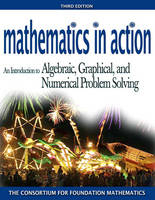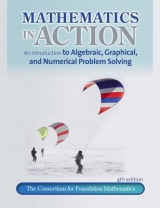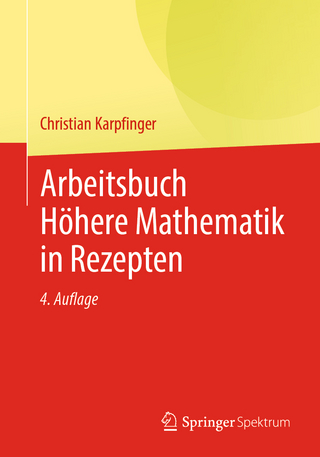
Mathematics in Action
Pearson (Verlag)
978-0-321-44448-6 (ISBN)
- Titel erscheint in neuer Auflage
- Artikel merken
The second book of a three-part series, An Introduction to Algebraic, Graphical, and Numerical Problem Solving, Third Edition, illustrates how mathematics arises naturally from everyday situations through updated and revised real-life activities and the accompanying practice exercises. Along with the activities and the exercises within the text, MathXL® and MyMathLab™ have been enhanced to create a better overall learning experience for the student.
This unique approach helps students increase their knowledge of mathematics, sharpen their problem-solving skills, and raise their overall confidence in their ability to learn. Technology integrated throughout the text helps students interpret real-life data algebraically, numerically, symbolically, and graphically. The active style of this book develops students' mathematical literacy and builds a solid foundation for future study in mathematics and other disciplines.
Chapter 1: Number Sense
Cluster 1: Introduction to Problem Solving with Whole Numbers
Activity 1.1: The Bookstore
Objectives: 1. Practice communication skills
2. Organize information
3. Write a solution in sentences
4. Develop problem-solving skills
Activity 1.2: The Classroom
Objectives: 1. Organize information
2. Develop problem-solving strategies
-Draw a picture
-Recognize patterns
-Do a simpler pattern
3. Communicate problem-solving ideas
Activity 1.3: Problem Solving and Your Calendar
Objectives: 1. Identify and use the commutative property in calculations
2. Use the distributive property to evaluate arithmetic expressions
3. Use the order of operations convention to evaluate arithmetic expressions
4. Identify and use the properties of exponents in calculation
5. Convert numbers to and from scientific notation
6. Identify, understand, and use formulas
7. Use the order of operations in formulas involving whole numbers
Project Activity 1.4: The Class Schedule
Objective: 1. Use algorithms to solve problems
What Have I Learned?
How Can I Practice?
Cluster 2: Problem Solving with Fractions and Decimals (Rational Numbers)
Activity 1.5: Delicious Recipes
Objectives: 1. Add and subtract fractions
2. Multiply and divide fractions
Activity 1.6: Course Grades and Your GPA
Objectives: 1. Solve problems using fractions and decimals
2. Recognize and calculate a weighted average
Project Activity 1.7: Income and Expenses
Objective: Solve problems with fractions and decimals
What Have I Learned?
How Can I Practice?
Cluster 3: Comparisons and Proportional Reasoning
Activity 1.8: Everything is Relative
Objectives: 1. Distinguish between absolute and relative measure
2. Write ratios in fraction, decimal, and relative measure
3. Determine equivalence of ratios
Activity 1.9: The Devastation of AIDS in Africa
Objectives: 1. Use proportional reasoning to apply a known ratio to a given piece of information
2. Write a proportion and then solve the resulting proportion
Activity 1.10: Who Really Did Better?
Objectives: 1. Define actual and relative change
2. Distinguish between actual and relative change
3. Calculate relative change as a percent increase or percent decrease
Activity 1.11: Going Shopping
Objectives: 1. Define growth factor
2. Determine growth factors from percent increases
3. Apply growth factors to problems involving percent increases
4. Define decay factor
5. Determine decay factors from percent decreases
6. Apply decay factors to problems involving percent decreases
Activity 1.12: Take an Additional 20% Off
Objectives: 1. Define consecutive growth and decay factors
2. Determine a consecutive growth or decay factor from two or more consecutive percent changes
3. Apply consecutive growth and/or decay factors to solve problems involving percent changes
Activity 1.13: Fuel Economy
1. Apply rates directly to solve problems
2. Use proportion equations to solve problems involving rates
3. Use unit or dimensional analysis to solve problems that involve consecutive rates
Project Activity 1.14: Take it To Heart
Objective: 1. Solve problems involving percents, formulas, and proportional
Reasoning
What Have I Learned?
How Can I Practice?
Skills Check 1
Cluster 4: Problem Solving with Signed Numbers
Activity 1.15: Celsius Thermometers
Objectives: 1. Identify signed numbers
2. Use signed numbers to represent quantities in real-world situations
3. Compare signed numbers
4. Calculate the absolute value of numbers
5. Identify and use properties of addition and subtraction of signed numbers
6. Add and subtract signed numbers using absolute value
Activity 1.16: Shedding the Extra Pounds
Objective: Multiply and divide signed numbers
Activity 1.17: Order of Operations Revisited
Objectives: 1. Use the order of operations convention to evaluate expressions involving signed numbers
2. Evaluate expressions that involve negative exponents
3. Distinguish between -54 and (-5)4
4. Write very small numbers in scientific notation
What Have I Learned?
How Can I Practice?
Skills Check 2
Chapter 1 Summary
Chapter 1 Gateway Review
Chapter 2: Variable Sense
Cluster 1: Interpreting and Constructing Tables and Graphs
Activity 2.l: Blood-Alcohol Levels
Objectives: 1. Identify input and output in situations involving two variable quantities
2. Use a table to numerically represent a relationship between two variables
3. Represent a relationship between two variables graphically
4. Identify trends in data pairs that are represented numerically and graphically
Activity 2.2: Earth's Temperature
Objectives: 1. Construct a graph of data pairs using an appropriately scaled and labeled rectangular coordinate system
2. Determine the coordinates of a point on a graph
3. Construct a table of data pairs using the data points on a graph
4. Identify points that lie in a given quadrant or on a given axis
Activity 2.3: College Expenses
Objectives: 1. Identify input variables and output variables
2. Determine possible replacement values for the input
3. Write variable rules that represent relationships between input and output variables
4. Construct tables of input/output values
5. Construct graphs from input/output tables
Activity 2.4: The Write Way to Learn Algebra
Objectives: 1. Translate verbal phrases into symbolic (algebraic) expressions
2. Distinguish between a factor and a term in an algebraic expression
3. Evaluate algebraic expressions for specified input values
Lab Activity 2.5: How Many Cups Are in That Stack?
Objectives: 1. Collect input/output data
2. Represent input/output data numerically in tables
3. Construct tables of data pairs for graphing
4. Graph input/output data pairs
Project Activity 2.6: Body Parts
Objectives: 1. Collect input/output data
2. Represent input/output data numerically in a table
3. Construct graphs from tables of data pairs
What Have I Learned?
How Can I Practice?
Cluster 2: Solving Equations Numerically, Graphically, and Algebraically
Activity 2.7: Fundraiser
Objectives: 1. Translate verbal rules (statements using words) to symbolic rules (equations)
2. Distinguish an algebraic expression from an equation and from a symbolic rule
3. Solve an equation numerically and graphically
4. Distinguish between a graph of distinct points and a graph of a continuous line
Activity 2.8: Let's Go Shopping
Objectives: 1. Translate verbal rules into symbolic ones
2. Solve an equation of the form ax = b, a ≠ 0, for x using an algebraic approach
3. Solve an equation of the form x + a = b for x using an algebraic approach
Activity 2.9: Are They the Same?
Objectives: 1. Translate verbal rules into symbolic (algebraic) rules
2. Write algebraic expressions that involve grouping symbols
3. Evaluate algebraic expressions containing two or more operations
4. Identify equivalent algebraic expressions by examining their outputs
Activity 2.10: Sherlock Holmes
Objective: 1. Recognize the conceptual basis for solving equations algebraically
Activity 2.11: Leasing a Copier
Objectives: 1. Model contextual situations with symbolic rules of the form y = ax + b, a ≠ 0
2. Solve equations of the form ax + b = c, a ≠ 0
Activity 2.12: How Long Can You Live?
Objectives: 1. Represent sets of data by a regression equation of the form y = ax + b, a ≠ 0
2. Solve equations of the form ax + b = c, a ≠ 0
3. Solve problems involving equations of the form ax + b = c, a ≠ 0
Activity 2.13: The Algebra of Weather
Objectives: 1. Evaluate formulas for specified input values
2. Solve a formula for a specified variable
What Have I Learned?
How Can I Practice?
Cluster 3: Mathematical Modeling and Problem Solving
Activity 2.14: Do It Two Ways
Objectives: 1. Apply the distributive property
2. Use areas of rectangles to interpret the distributive property geometrically
3. Identify equivalent expressions
Activity 2.15: Ring It Up!
Objectives: 1. Identify the greatest common factor in an expression
2. Factor out the greatest common factor in an expression
3. Recognize like terms
4. Simplify an expression by combining like terms
Lab Activity 2.16: Math Magic
Objectives: 1. Recognize an algebraic expression as a code of instruction
2. Simplify algebraic expressions
Activity 2.17: Comparing Energy Costs
Objectives: 1. Translate verbal rules into symbolic rules
2. Write and solve equations of the form ax + b = cx + d
3. Use the distributive property to solve equations involving grouping symbols
4. Develop mathematical models to solve problems
5. Solve formulas for a specified variable
Project Activity 2.18: Summer Job Opportunities
Objective: 1. Use critical thinking skills to make decisions based on solutions of systems of two linear equations
What Have I Learned?
How Can I Practice?
Chapter 2 Summary
Chapter 2 Gateway Review
Chapter 3: Function Sense and Linear Functions
Cluster 1: Function Sense
Activity 3.1: Graphs Tell Stories
Objectives: 1. Describe in words what a graph tells you about a given situation
2. Sketch a graph that best represents a situation that is described in words
3. Identify increasing, decreasing, and constant parts of a graph
4. Identify minimum and maximum points on a graph
5. Define a function
6. Use the vertical line test to determine whether a graph represents a function
Activity 3.2: Course Grade
Objectives: 1. Represent functions numerically, graphically, and symbolically
2. Determine the symbolic rule that defines a function
3. Use function notation to represent functions symbolically
4. Identify the domain and range of a function
5. Identify the practical domain and range of a function
Activity 3.3: How Fast Did You Lose?
Objective: 1. Determine the average rate of change of an output variable with respect to the input variable
What Have I Learned?
How Can I Practice?
Cluster 2: Introduction to Linear Functions
Activity 3.4: The Snowy Tree Cricket
Objectives: 1. Identify linear functions by a constant rate of change of the output variable with respect to the input variable
2. Determine the slope of the line drawn through two points
3. Identify increasing linear functions using slopes
Activity 3.5: Descending in an Airplane
Objectives: 1. Identify lines as having negative, zero, or undefined slopes
2. Identify a decreasing linear function from its graph or slope
3. Determine horizontal and vertical intercepts of a linear function from its graph
4. Interpret the meaning of horizontal and vertical intercepts of a line
Activity 3.6: Charity Event
Objectives: 1. Determine a symbolic rule for a linear function from contextual information
2. Identify the practical meanings of the slope and intercepts of a linear function
3. Determine the slope-intercept form of a linear function
4. Identify functions as linear by numerical, graphical, and algebraic characteristics
Activity 3.7: Software Sales
Objectives: 1. Identify the slope and vertical intercept from the equation of a line written in slope-intercept form
2. Write an equation of a line in the slope-intercept form
3. Use the y-intercept and the slope to graph a linear function
4. Determine horizontal intercepts of linear functions using an algebraic approach
5. Use intercepts to graph a linear function
What Have I Learned?
How Can I Practice?
Cluster 3: Problem Solving with Linear Functions
Activity 3.8: Predicting Population
Objectives: 1. Write an equation for a linear function given its slope and y-intercept
2. Write linear functions in slope-intercept form
3. Determine the relative error in a measurement or prediction using a linear model
4. Interpret the slope and y-intercept of linear functions in contextual situations
5. Use the slope-intercept form of linear equations to solve problems
Activity 3.9: Housing Prices
Objectives: 1. Determine the slope and y-intercept of a line algebraically and graphically
2. Determine the equation for a linear function when given two points
3. Interpret the slope and y-intercept of a linear function in contextual situations
Activity 3.10: Oxygen for Fish
Objectives: 1. Construct scatterplots from sets of data
2. Recognize when patterns of points in a scatterplot are approximately linear
3. Estimate and draw a line of best fit through a set of points in a scatterplot
4. Use a graphing calculator to determine a line of best fit by the least-squares method
5. Estimate the error of representing a set of data by a line of best fit
What Have I Learned?
How Can I Practice?
Cluster 4: Systems of Two Linear Equations
Activity 3.11: Business Checking Account
Objectives: 1. Solve a system of two linear equations numerically
2. Solve a system of two linear equations graphically
3. Solve a system of two linear equations symbolically by the substitution method
4. Recognize the connections among the three methods of solution
5. Interpret the solution to a system of two linear equations in terms of the problem's content
Activity 3.12: Healthy Lifestyle
Objectives: 1. Solve a system of two linear equations algebraically using the substitution method and the addition method
2. Solve equations containing parentheses
Activity 3.13: Modeling a Business
Objectives: 1. Solve a system of two linear equations by any method
2. Determine the break-even point of a linear system algebraically and graphically
3. Interpret break-even points in contextual situations
Activity 3.14: How Long Can You Live?
Objectives: 1. Use properties of inequalities to solve linear inequalities algebraically
2. Solve compound inequalities algebraically and graphically
3. Solve linear inequalities graphically
What Have I Learned?
How Can I Practice?
Chapter 3 Summary
Chapter 3 Gateway Review
Chapter 4: An Introduction to Nonlinear Problem Solving
Cluster 1: Mathematical Modeling Involving Polynomials
Activity 4.1: Fatal crashes
Objectives: 1. Identify polynomials and polynomial functions
2. Classify a polynomial as a monomial, binomial, or trinomial
3. Determine the degree of a polynomial
4. Simplify a polynomial by identifying and combining like terms
5. Add and subtract polynomials
6. Evaluate and interpret polynomials
Activity 4.2: Volume of a Storage Tank
Objectives: 1. Use properties of exponents to simplify expressions and combine powers that have the same base
2. Use the distributive property and properties of exponents to write expressions in expanded form
3. Identify the greatest common factor (GCF) in an algebraic expression
4. Factor algebraic expressions completely
5. Use the distributive property to check factored algebraic expressions
Activity 4.3: Room for Work
Objectives: 1. Expand and simplify the product of two binomials
2. Expand and simplify the product of any two polynomials
3. Recognize and expand the product of conjugate binomials: difference of squares
4. Recognize and expand the product of identical binomials: perfect-square trinomials
What Have I Learned?
How Can I Practice?
Cluster 2: Problem Solving with Quadratic Equations and Functions
Activity 4.4: The Amazing Property of Gravity
Objectives: 1. Evaluate functions of the form y = ax2
2. Graph functions of the form y = ax2
3. Interpret the coordinates of points on the graph of y = ax2 in context
4. Solve an equation of the form ax2 = c graphically
5. Solve an equation of the form ax2 = c algebraically by taking square roots
6. Solve an equation of the form (x ± a) 2 = c algebraically by taking square roots
Activity 4.5: What Goes Up, Comes Down
Objectives: 1. Evaluate quadratic functions of the form y = ax2 + bx
2. Graph functions of the form y = ax2 + bx, a = 0
3. Identify the x-intercepts of the graph of y = ax2 + bx graphically and algebraically
4. Interpret the x-intercepts of a quadratic function in context
5. Factor a binomial of the form ax2 + bx
6. Solve an equation of the form ax2 + bx =0 using the zero-product rule
Activity 4.6: How High Did It Go?
Objectives: 1. Recognize and write a quadratic equation in standard form, ax2 + bx + c = 0
2. Factor trinomials of the form x2 + bx + c
3. Solve a factorable quadratic equation of the form x2 + bx + c = 0 using the zero-product rule
4. Identify a quadratic function from its algebraic form
Activity 4.7: More Ups and Downs
Objectives: 1. Use the quadratic formula to solve quadratic equations
2. Identify the solutions of a quadratic equation with points on the corresponding graph
What Have I Learned?
How Can I Practice?
Cluster 3: Other Nonlinear Functions
Activity 4.8: Inflation
Objectives: 1. Recognize an exponential function as a rule for applying a growth factor or a decay factor
2. Graph exponential functions from numerical data
3. Recognize exponential functions from symbolic rules
4. Graph exponential functions from symbolic rules
Activity 4.9: Diving Under Pressure, or Don't Hold Your Breath
Objectives: 1. Recognize functions of the form y = k/x, x ≠ 0, as nonlinear
2. Recognize equations of the form xy = k as inverse variation
3. Graph an inverse variation relationship from symbolic rules
4. Solve equations of the form a/x = b, x ≠ 0
Activity 4.10: Hang Time
Objectives: 1. Recognize functions of the form y = a/x as nonlinear
2. Evaluate and solve equations that involve square roots
3. Graph square root functions from numerical data
4. Graph square root functions from symbolic rules
What Have I Learned?
How Can I Practice?
Chapter 4 Summary
Chapter 4 Gateway Review
Appendixes
Appendix A: Fractions
Appendix B: Getting Started with the TI-83/TI-84 Plus Family of Calculators
Appendix C: Algebraic Extensions
Appendix D: Decimals
Appendix E: Learning Math Opens Doors: Twelve Keys to Success
Selected Answers
Glossary
Index
| Erscheint lt. Verlag | 17.4.2007 |
|---|---|
| Sprache | englisch |
| Maße | 216 x 276 mm |
| Gewicht | 1311 g |
| Themenwelt | Mathematik / Informatik ► Mathematik ► Algebra |
| ISBN-10 | 0-321-44448-5 / 0321444485 |
| ISBN-13 | 978-0-321-44448-6 / 9780321444486 |
| Zustand | Neuware |
| Haben Sie eine Frage zum Produkt? |
aus dem Bereich



